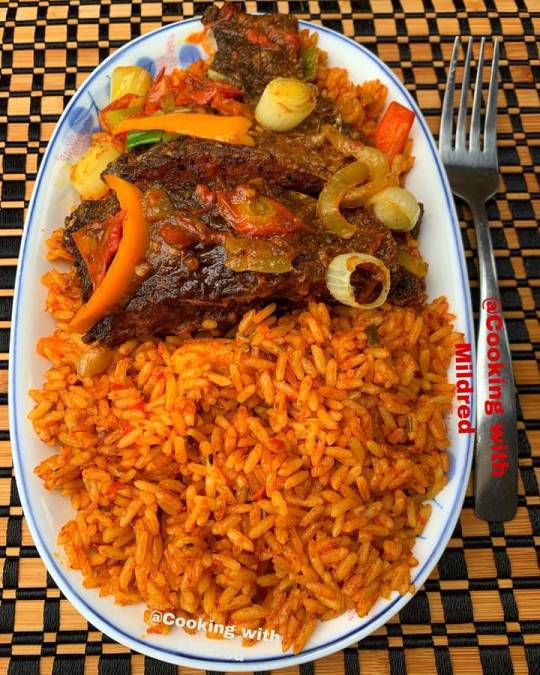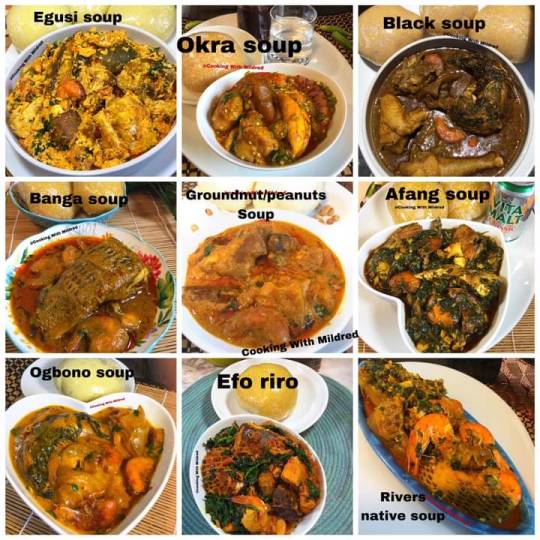#west african food
Text

AFANG - Tripe Stew from West Africa
Without any iota of doubt, soups are a big part of the African cuisine, in fact, it is wise to say that African soups are the main attraction of cuisine in the continent.
African soups can be made with a combination of vegetables and ingredients that are native to the countries where they are most eaten.
Very many African soups are usually eaten with other food staples such as rice, fufu, banku, sadza, garri, pounded yam, and so on.
Below are some of our favorite soups from different African countries.
1. Okra soup
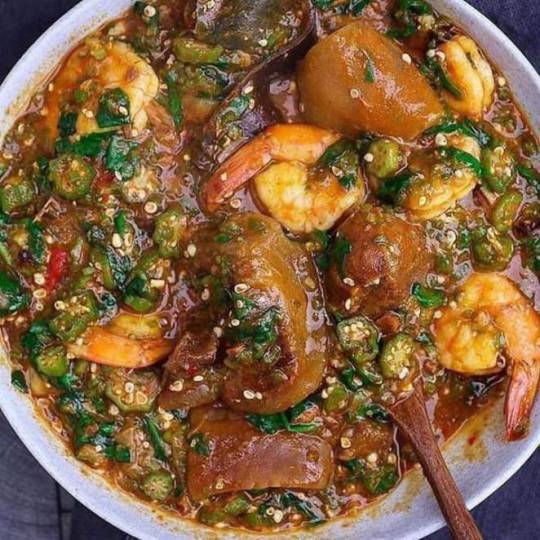
Okra soup is a popular west African dish with okra as its main ingredient. Although this deliciously slimy dish can be cooked with the local palm oil, it is also a good choice for people who are wary of adding oil to their soups.
2. Abenkwan
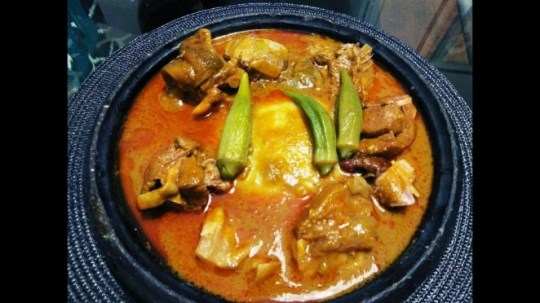
Abenkwan is a Ghanaian soup made from the nuts of the palm tree. The pulp is extracted from the palm fruits and cooked in combination with spices and preferred meat of choice.
Abenkwan has an earthy flavor thanks to the addition of the palm fruit pulp (which is different from the palm oil). Serve warm with rice balls or Kokonte and you will be satisfied to the moons and back.
3. Muriwo na Nyama
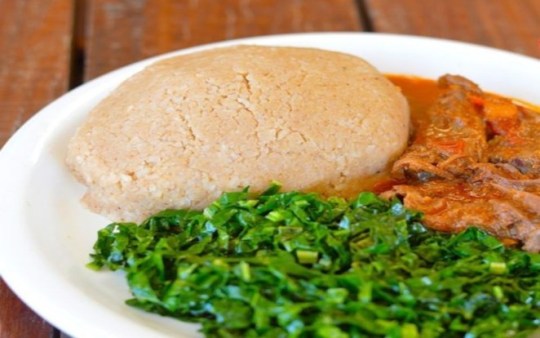
Muriwo na nyama is also known as leafy-beefy or high fields stew. It is native to Zimbabwe, highly nutritious and cn be eaten with sadza.
4. Pepper soup

Pepper soup is a spicy African soup that will make your taste buds tingle with excitement. The soup is gotten from the stock of the meat or fish used. It is also spiced with local ingredients, giving it a tantalizing aroma and taste that will make you hungry even if you just had dinner.
For the best experience, have your pepper soup hot–not scalding hot of course– and thank us later.
5. Agushie/Egusi soup

Agushie (Ghana)/Egusi(Nigeria) is a delicious soup cooked with shelled melon seeds. The method of preparation might differ across the different regions in which this soup is eaten but it ultimately includes the addition of leafy greens, seasoning and palm oil. In Nigeria, its best served with freshly pounded yam.
6. Domoda

Domoda is the Gambia’s national dish, second only to Yassa. It is a yummy soup cooked with unsweetened peanut butter. It might also contain sweet potatoes. Domoda is better enjoyed with rice.
7. Afang
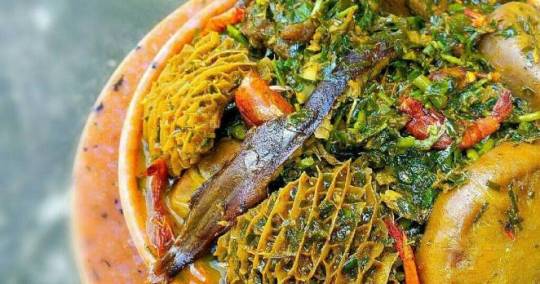
Afang is a delightful and satisfying soup from southern Nigeria. It is similar to the eru soup in Cameroon. They both make use of the afang/okazi leaves. However, the afang leaves are pounded and used in addition to water leaf. Afang soup is rich in deliciousness and best served hot with fufu and lots of meat.
8. Ndole
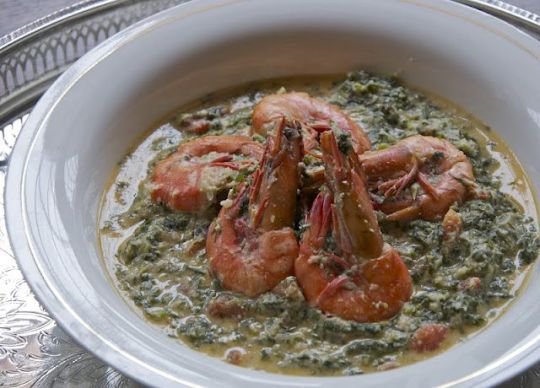
Ndole is another leafy vegetable soup with its home in Cameroon. It is often considered the national dish of the central African country. It’s a creamy and nutritious soup cooked with pureed peanuts and bitter leaf.
9. Afia efere/Ofe nsala

In the Nigerian local languages of Annang and Igbo, afia efere and ofe nsala respectively mean ‘white soup’ in English. Technically, this mouth-watering spicy soup should be called ‘brown soup’ but where’s the fun in that? It is apparently called ‘white’ for the lack of palm oil use.
10. Ewedu Soup
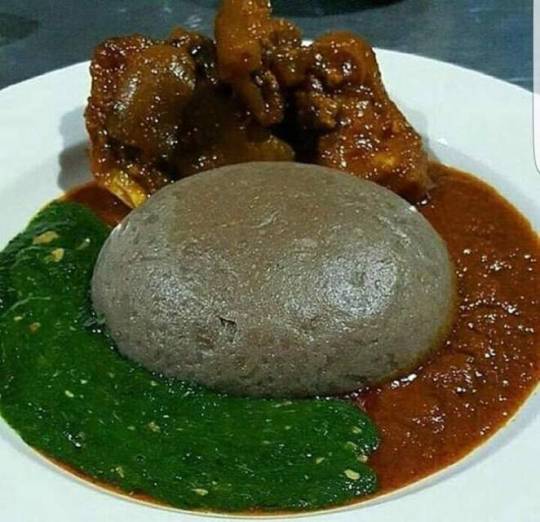
Ewedu is a Nigerian soup which is popular among the Yorubas. It’s a leafy vegetable soup but unlike other African soups, the greens (jute leaves) are pureed and cooked with nothing more than salt, locust beans and often potash.
It is usually served in addition to peppered stews (as pictured above) or gbegiri (beans soup). Yorubas love to eat this with amala, a starchy swallow made from yam peels and sometimes plantains.
#west african food#cooking#african food#stews#soups#main dish#african#Top 10 Delicious African Soups That Will Make You Salivate And Where They Are Best Made
34 notes
·
View notes
Text
How To Make The Authentic Ghana Local Jollof Rice, Your Family Would Be ...
youtube
0 notes
Text
Exploring West African Cuisine in Tokyo

View On WordPress
#African Home Touch#African Restaurant & Bar Esogie#アフリカンホームタッチ レストラン & バー#アフリカンレストラン&バー エソギエ#egusi soup#Nigerian restaurants in japan#nigerian restaurants in tokyo#nigerians in japan#nigerians in tokyo#Shinjuku#tokyo japan#west African food
0 notes
Text
Chef Nana Araba Wilmot Bringing Her West African Cuisine to River Twice
Chef Nana Araba Wilmot Bringing Her West African Cuisine to River Twice on @EPassyunkAve
When Chef Nana Araba Wilmot started her newest venture, ‘Love That I Knead Supper Club,’ a West African-focused dinner series that celebrates Black history and food from across the African diaspora, she began to explore her identity on a plate while also helping others to “find their way back,” spanning locations from Philadelphia to New York to Accra, the capital of Ghana.
Now, the chef and…
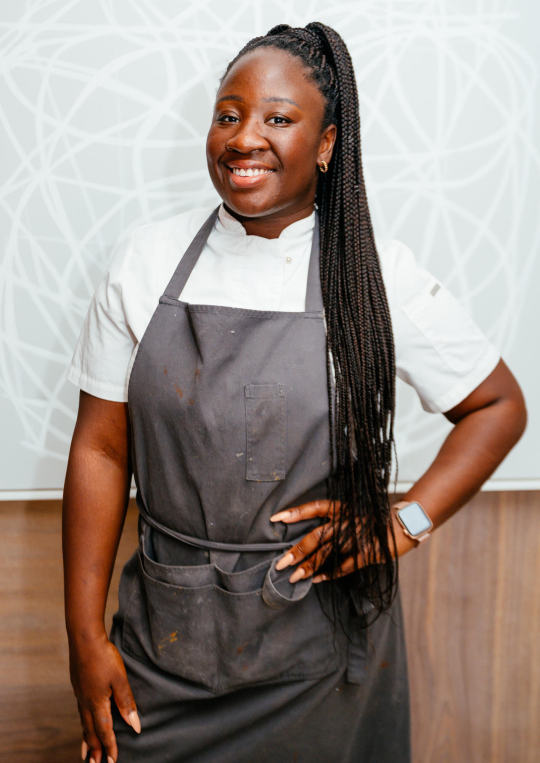
View On WordPress
#Chef Nana Araba Wilmot#Chef Randy Rucker#Easy Passyunk Avenue restaurant#River Twice#West African food
0 notes
Text
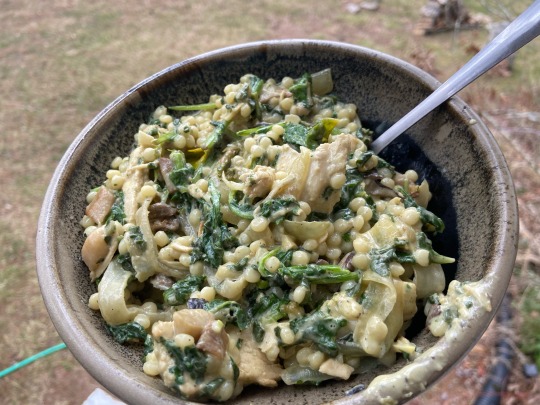
Lunchmaxxing we got toasted pearl couscous, baby kale (soooooo quick and easy to grow at home if you’ve got a south facing window and a seeding flat. but that’s another story), oyster mushrooms, white onion, tangerine rind, fish sauce, and garlic slices in a white wine cream sauce w/ freshly cracked pepper & some parmesan
#also the kale comment is kind of a joke I know that’s quite out of the ordinary lol#getting to a place where you can improvise meals with what you have on hand is like…pinnacle of achievement in my onion…#but half the time you improvise something and it’s eh and you have four days worth of slop to choke down lol#rip to my ‘I don’t need a recipe’ west African peanut and yam stew in the fridge. failed THAT one lol#eating it in small portions for the next week probably lmao#food
10 notes
·
View notes
Text
everybody stop this madness hobie (spidey punk) is not eating fucking beans on toast HE IS EATING FOOD WITH FLAVOUR!!!!!!!!!!!!!!!!!!!!!!!!
#HE IS EATING BUN AND CHEESE FOR BREAKFAST OR MAYBE YAM AND SCRAMBLED EGGS NOT NO FUCKING BEANS ON TOAST#<- before u start making some british jokes these are both west African and jamaican dishes so hush your mouth NEOW#everybody itching to make british jokes for hobie but they're leaving out that he is not eating food that is boiled water flavoured#he may be poor and homeless but he knows flavourful food. he is not like these white brits u keep making fun of!
34 notes
·
View notes
Text

Tatale / Ghanaian Plantain Pancakes (Vegan)
#vegan#breakfast#street food#ghanaian cuisine#west african cuisine#african cuisine#pancakes#plantains#scotch bonnet peppers#cayenne#rice flour#palm oil#ginger#onion#sea salt#🤎
65 notes
·
View notes
Text

#capeverdean#capeverde#west africa#travel#african food#islands#cape verde#african#africa#capvert#exotic#food
17 notes
·
View notes
Text
West African countries like Nigeria, Senegal, Mali and Ghana are now sought-after for their largely unexplored cuisine. The international community has started to recognize the region’s vibrant and healthy ingredients and flavours that could rival that of South-East Asia. West African cuisine is spicy, wholesome and ideal for one-pot dishes that perfectly resonates with the current demand in the food industry. This emerging cuisine is believed to be the next big thing this year and could even surpass Indian food as the new takeaway choice of many.
West African cuisine and innovation
With the number of innovation in the open food markets on the rise, more and more international brands are starting to adopt West African techniques, flavours and combining these with their own. Product innovation includes some key ingredients used in most West African dishes like cassava, okra, plantain, moringa, kola nuts, yam, beans, sorghum, peanuts, ginger, scotch bonnet chillies, and fonio.
Even with the increasing number of people converting to different dietary changes and restrictions, West African cuisine does not seem fazed, thanks to their mainly plant-based and gluten-free dishes. Vegans and vegetarians can still enjoy a big serving of a West-African dish minus the guilt.
West African Cuisine becoming more accessible to the international scene
The rise of some renowned kitchen superstars from West Africa helped in the introduction of West African cuisines to the international food community in the UK and other western countries. The Ghanaian born Zoe Adjonyoh, for example, led the change in raising awareness on the diverse cuisines of her home country by starting her business and writing a book with the same name Zoe’s Ghana Kitchen.
Another notable woman, an ambassador for West African cuisine, a cooking instructor, a published author, business mentor and an advocate for women in leadership, Ebere Akadiri, brought West African cuisine into the Netherlands with her ‘Vibrant West African Cuisine” cooking workshops, video course, packaged signature spice blends and a cookbook entitled Vibrant West African Cuisine. Her brand “Ataro” changed the narratives in the Netherlands even before West African Cuisine became a trend in Europe.
The owner of the first ever Nigerian fine dining restaurant with a Michelin star in the UK, Ikovi, used traditional Nigerian ingredients and combined them with the contemporary techniques used in the West and the result was a new and exciting fusion of flavours that appealed to the European market.
There is a growing opportunity in Europe for emerging cuisines like that of West Africa. The ingredients are natural and easy to find, can be elaborately and paired merely with contemporary cooking methods used in the West and there is a growing number of people craving for an innovative, safe and tasty food adventure.
#How Does West African Cuisine Fit in Today’s Food Trends? - Vibrant West Afrian Cuisine#west african food#world food#african food#africa#cuisine#global cuisine#cooking healthy
5 notes
·
View notes
Text
0 notes
Note
confession : I'm only vaguely aware of plantains existing as concept from doing research for a banana post a while ago. but don't actually know what they are tbh or what you'd even do with them ?? don't think I've ever seen one irl ? hope you get some soon though
They’re slightly larger than a banana and usually darker, but look just like them otherwise. They also have a similar texture to bananas but they taste almost like potatoes. They’re one of the biggest staples in Caribbean cuisines and west African cuisines alongside rice. You can fry them, bake them, mash them, dry them into little chips (just like you can with bananas). So basically they’re like the savory version of a banana and pair well with rice, beans, chicken, pork, beef, stir fry, etc. or you can fry them on their own and dip the slices into a condiment of your choice for a snack. They’re excellent for people shopping on a budget because they’re super cheap, filling and versatile.
For your viewing pleasure:
Mofongo (Caribbean) —mashed plantains
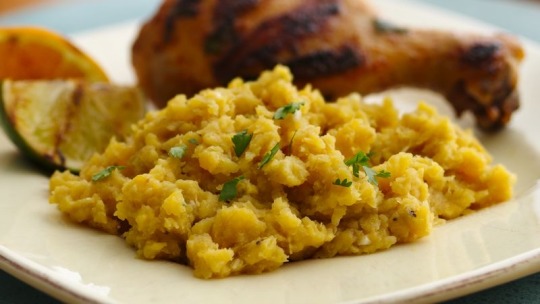
Fried plantain slices

Plantain chips
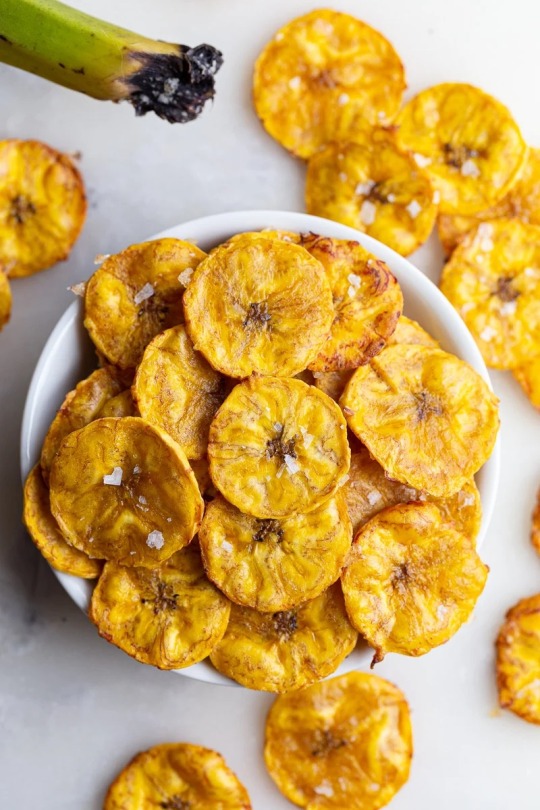
Fufu (West African) —dough made of plantains and cassava (cassava is a plant responsible for the texture of tapioca).

Tostones (Latin American/Caribbean) —deep fried plantains
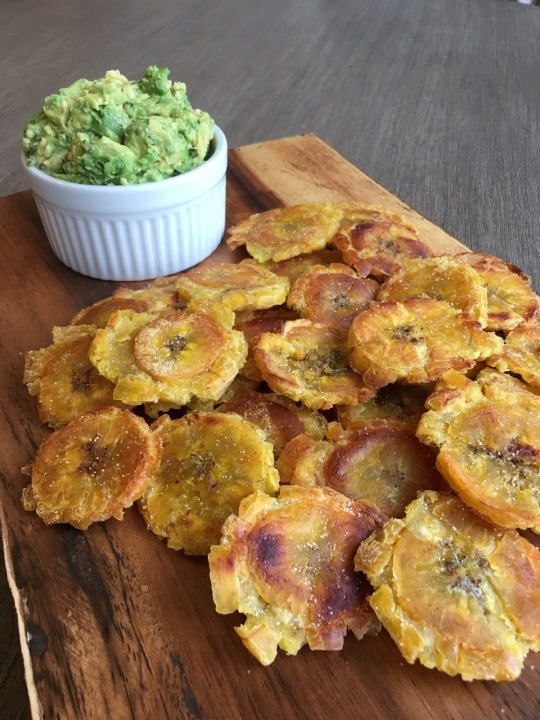
15 notes
·
View notes
Text
aughhhhh i got takeout from a restaurant 30 mins away from me that has weird hours (had wanted to eat in but they unexpectedly just had the chef/owner there when i went to make a reservation so got takeout instead) i've been really really excited to go to for so long and i guess i accidentally didnt notice on the phone when she repeated my order and had heard me say an extra thing i didnt order. but even if i didnt mean to order it and it made it more expensive than i planned i didnt say anything about it once we got it because coincidentally it was the meal i almost wanted to order instead!
we were planning on eating outside the restaurant bc she said we could bc it has outdoor seating but it was like 90°F out and after like 10 mins i started to realize i had heat exhaustion from being out in the sun for like 3 hours prior so we drove 25 mins to my friends house to eat only to realize when we got there the fridge was broken. and i thought it was maybe getting back up to temp so after it cooled a bit i put my extra meal in there but when we left like 5 and a half hours later it has hardly cooled in there
and then the next day i moved it for a second in my fridge to get something behind it but then didnt realize i left it on the counter til like 45 minutes later
but the thing is my firsg meal was sooooo tasty and i was so excited about this meal because it even had extra ingredients id been really craving recently that i didnt even think it would have. and i spent so much money on everything and i dont know when ill next be able to fit going to that restaurant into my schedule
so even though i Know as a certified servsafe food manager that that is such a recipe for food poisoning i was like. well. its worth it maybe to risk it to at least try a little bit of it…
so i did for dinner last night i had half of it and it was so fucking incredibly delicious
but then i couldnt go to sleep for 4 hours past when i wanted to because my stomach started to feel weird. and now i just feel so so awful almost 24 hours after eating it lol
i absolutely did this to myself i knew it was highly likely so i cant really complain. the fucked up thing is honestly i still feel it was worth it it just was so fucking good
#cpost#unsanitary -#contamination -#im at least not eating and theowing out the other half of it tho lol#idk why i wrote this so vague but jsyk its like the only west african restaurant within hours of here#and ive really missed all the west african food i used to have in chicago#my first meal was beef asaro with a side of fried plantains#and my second was goat pepper soup
2 notes
·
View notes
Text
I am attempting to make jollof rice tonight 😋
#I’m very excited. I’ve been meaning to try a lot of west African dishes for a while now bc they look phenomenal but there’s no place locally#that does it#my gram also brought six massive homegrown tomatoes which are gonna be so good omg#man I love cooking when I’m not dying of fatigue Lmao#ramblings#food mention
13 notes
·
View notes
Text
Reflections on Ethnic Classifications of Liberian Indigenous Pt. 1
I felt like making this to rumniate on the differences in how indigenous identity is considered/counted amongst Liberians (and potentially other west african countries) and the turtle-island indigenous. Being born and raised in the U.S as a result of my mother fleeing the civil war as a child, means that most of my understanding when it came to indigenous structure and classification were influenced by the dominant understanding of tribes and nations here. So in order to better understand my own culture, I had to do individual research into how tribal structure functioned.
(Please note that I am NOT turtle-island indigenous and may have some facts confused.)
Geographical regions, language diversity, and cultural divisions are used to categorize Indigenous peoples of the Americas. Anthropologists have given names to a variety of cultural zones that have ambiguous borders and are usually accepted with some modification.
Since the commencement of early European and African contact in the late 15th century, these cultural divisions have been mostly based on the locations of Indigenous peoples of the Americas. Indigenous peoples retain their original geographic categorisation after being forcibly evicted by nation-states. For example: Cherokee Nation, Eastern Band of Cherokee Indians, and the Keetoowah Band of Cherokee Indians. They are all Cherokee (Tsalagi) both linguistically and ethnically, but have different registrations with U.S government and are now located in different states in the U.S (due to Andrew Jackson's removal policy).
However, Liberia and Cote D'Ivoire are quite different. Currently, indigenous populations along the gold coast (Liberia, Cote D'Ivoire, and Sierra Leone) can be categorized into three ethno-liguistic enclaves, one of which being Kru. Within Kru are even smaller "tribes," such as the Bassa, Grebo, and Krahn, and Krao/Klao. These groups, however, only possess linguistic affiliation internally, that even varies in dialect based on the distances between two dako (village). Due to this would be rather inaccurate to claim there is a Krao/Klao "tribe" in the western understanding of the word and more accurate to say the are multiple dako (dakwe) that speak the similar language/dialect and call themselves Krao/Klao on occasion. The strongest depiction of ethnicity, thus far remains at the Dako level.
These dialects are at times even mutually unintelligible. Hence why traditional understandings of a "tribe" may not apply here. The closest example I can consider, and even then doesn't fit well, would be tribal classification of indigenous mexicans, where it is tied moreso to one's native village and language, rather than a political identity.
A major player in the confusion and misunderstanding of Kru identity resides in the fact that multiple European countries in contact revolved around migrant labor. Many indigenous Liberians, particulary "Kru-speaking" peoples worked as stevedores on European ships. The conlfation/corruption of Krao/Klao with "Crew" and later "Kru/Krumen/Krooboys" despite the identity of a native's dako lead to many being mistakenly affiliated with the ethnic grouping.
#food for thought#west african indigenous#reconnecting indigenous#claiming indigeneity#west africa#liberia#liberian#klao people#kru#long post
4 notes
·
View notes
